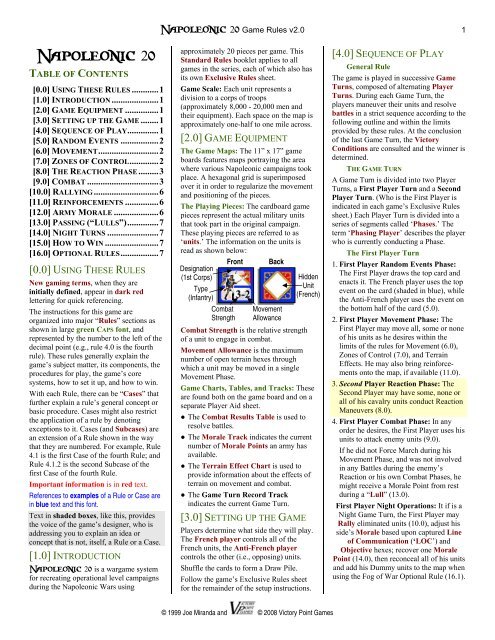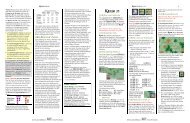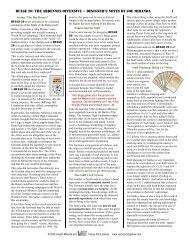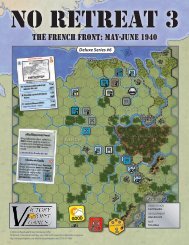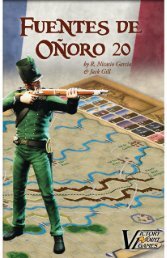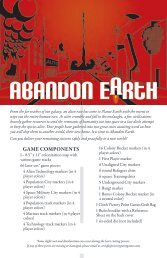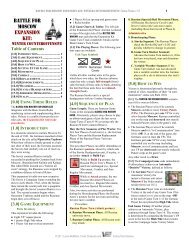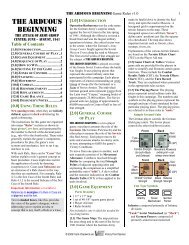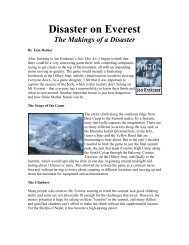Standard game rules - Victory Point Games
Standard game rules - Victory Point Games
Standard game rules - Victory Point Games
You also want an ePaper? Increase the reach of your titles
YUMPU automatically turns print PDFs into web optimized ePapers that Google loves.
Napoleonic 20 Game Rules v2.0 1Napoleonic 20TABLE OF CONTENTS[0.0] USING THESE RULES ............1[1.0] INTRODUCTION .....................1[2.0] GAME EQUIPMENT ...............1[3.0] SETTING UP THE GAME ........1[4.0] SEQUENCE OF PLAY..............1[5.0] RANDOM EVENTS .................2[6.0] MOVEMENT...........................2[7.0] ZONES OF CONTROL.............2[8.0] THE REACTION PHASE.........3[9.0] COMBAT ................................3[10.0] RALLYING.............................6[11.0] REINFORCEMENTS ...............6[12.0] ARMY MORALE ....................6[13.0] PASSING (“LULLS”)..............7[14.0] NIGHT TURNS .......................7[15.0] HOW TO WIN ........................7[16.0] OPTIONAL RULES.................7[0.0] USING THESE RULESNew gaming terms, when they areinitially defined, appear in dark redlettering for quick referencing.The instructions for this <strong>game</strong> areorganized into major “Rules” sections asshown in large green CAPS font, andrepresented by the number to the left of thedecimal point (e.g., rule 4.0 is the fourthrule). These <strong>rules</strong> generally explain the<strong>game</strong>’s subject matter, its components, theprocedures for play, the <strong>game</strong>’s coresystems, how to set it up, and how to win.With each Rule, there can be “Cases” thatfurther explain a rule’s general concept orbasic procedure. Cases might also restrictthe application of a rule by denotingexceptions to it. Cases (and Subcases) arean extension of a Rule shown in the waythat they are numbered. For example, Rule4.1 is the first Case of the fourth Rule; andRule 4.1.2 is the second Subcase of thefirst Case of the fourth Rule.Important information is in red text.References to examples of a Rule or Case arein blue text and this font.Text in shaded boxes, like this, providesthe voice of the <strong>game</strong>’s designer, who isaddressing you to explain an idea orconcept that is not, itself, a Rule or a Case.[1.0] INTRODUCTIONNapoleonic 20 is a war<strong>game</strong> systemfor recreating operational level campaignsduring the Napoleonic Wars usingapproximately 20 pieces per <strong>game</strong>. This<strong>Standard</strong> Rules booklet applies to all<strong>game</strong>s in the series, each of which also hasits own Exclusive Rules sheet.Game Scale: Each unit represents adivision to a corps of troops(approximately 8,000 - 20,000 men andtheir equipment). Each space on the map isapproximately one-half to one mile across.[2.0] GAME EQUIPMENTThe Game Maps: The 11” x 17” <strong>game</strong>boards features maps portraying the areawhere various Napoleonic campaigns tookplace. A hexagonal grid is superimposedover it in order to regularize the movementand positioning of the pieces.The Playing Pieces: The cardboard <strong>game</strong>pieces represent the actual military unitsthat took part in the original campaign.These playing pieces are referred to as‘units.’ The information on the units isread as shown below:FrontDesignation(1st Corps)Type(Infantry)CombatStrengthBackMovementAllowanceCombat Strength is the relative strengthof a unit to engage in combat.Movement Allowance is the maximumnumber of open terrain hexes throughwhich a unit may be moved in a singleMovement Phase.Game Charts, Tables, and Tracks: Theseare found both on the <strong>game</strong> board and on aseparate Player Aid sheet.● The Combat Results Table is used toresolve battles.● The Morale Track indicates the currentnumber of Morale <strong>Point</strong>s an army hasavailable.● The Terrain Effect Chart is used toprovide information about the effects ofterrain on movement and combat.● The Game Turn Record Trackindicates the current Game Turn.[3.0] SETTING UP THE GAMEHiddenUnit(French)Players determine what side they will play.The French player controls all of theFrench units, the Anti-French playercontrols the other (i.e., opposing) units.Shuffle the cards to form a Draw Pile.Follow the <strong>game</strong>’s Exclusive Rules sheetfor the remainder of the setup instructions.[4.0] SEQUENCE OF PLAYGeneral RuleThe <strong>game</strong> is played in successive GameTurns, composed of alternating PlayerTurns. During each Game Turn, theplayers maneuver their units and resolvebattles in a strict sequence according to thefollowing outline and within the limitsprovided by these <strong>rules</strong>. At the conclusionof the last Game Turn, the <strong>Victory</strong>Conditions are consulted and the winner isdetermined.THE GAME TURNA Game Turn is divided into two PlayerTurns, a First Player Turn and a SecondPlayer Turn. (Who is the First Player isindicated in each <strong>game</strong>’s Exclusive Rulessheet.) Each Player Turn is divided into aseries of segments called ‘Phases.’ Theterm ‘Phasing Player’ describes the playerwho is currently conducting a Phase.The First Player Turn1. First Player Random Events Phase:The First Player draws the top card andenacts it. The French player uses the topevent on the card (shaded in blue), whilethe Anti-French player uses the event onthe bottom half of the card (5.0).2. First Player Movement Phase: TheFirst Player may move all, some or noneof his units as he desires within thelimits of the <strong>rules</strong> for Movement (6.0),Zones of Control (7.0), and TerrainEffects. He may also bring reinforcementsonto the map, if available (11.0).3. Second Player Reaction Phase: TheSecond Player may have some, none orall of his cavalry units conduct ReactionManeuvers (8.0).4. First Player Combat Phase: In anyorder he desires, the First Player uses hisunits to attack enemy units (9.0).If he did not Force March during hisMovement Phase, and was not involvedin any Battles during the enemy’sReaction or his own Combat Phases, hemight receive a Morale <strong>Point</strong> from restduring a “Lull” (13.0).First Player Night Operations: It if is aNight Game Turn, the First Player mayRally eliminated units (10.0), adjust hisside’s Morale based upon captured Lineof Communication (‘LOC’) andObjective hexes; recover one Morale<strong>Point</strong> (14.0), then reconceal all of his unitsand add his Dummy units to the map whenusing the Fog of War Optional Rule (16.1).© 1999 Joe Miranda and © 2008 <strong>Victory</strong> <strong>Point</strong> <strong>Games</strong>
Napoleonic 20 Game Rules v2.0 2The Second Player Turn5. Repeat Phases 1 through 5, reversingthe roles of the First and SecondPlayers. If it is a Night Turn, reshufflethe Random Event cards to form anew Draw Pile.[5.0] RANDOM EVENTSGeneral Rule“Random events” simulate imponderablesof war that affected these campaigns. Atthe beginning of each Player Turn, thePhasing Player reveals the top RandomEvent card and immediately applies theappropriate result. ‘Two-tone’ events affectwhichever player drew that card; ‘monochrome’text affects its specific side.ProcedureThe deck is reshuffled at the end of eachNight Game Turn. Unless otherwisespecified, an individual event may takeplace more than once per <strong>game</strong> (i.e., eachtime the event is drawn from the deck).[6.0] MOVEMENTGeneral RuleDuring his Movement Phase, the PhasingPlayer may move as many or as few of hisunits as he desires. Units may be moved inany direction or combination of directions.ProcedureUnits are moved one at a time, tracing apath of contiguous hexes. As each unitenters a hex, the unit pays one or moreMovement <strong>Point</strong>s from its MovementAllowance to do so.Restrictions and Prohibitions[6.1] Strict Sequence: Movement nevertakes place out of sequence. A player’sunits may be voluntarily moved onlyduring his own Movement Phase(exception: see The Reaction Phase, 8.0).[6.2] Speed Limit: A unit cannot exceedits Movement Allowance during a friendlyMovement Phase, with the exception that aunit may always move 1 hex per friendlyMovement Phase (as long as it is not intoprohibited terrain or across a prohibitedhexside), even if it does not have sufficientMovement <strong>Point</strong>s to pay the entire cost. Aunit may expend all, some or none of itsMovement <strong>Point</strong>s at that time, but unusedMovement <strong>Point</strong>s may not be accumulatedfrom turn to turn, nor transferred to anotherunit.[6.3] Enemies: A friendly unit may neverenter a hex containing an enemy unit.[6.4] No ‘Take Backs:’ All movement isfinal once a player’s hand is withdrawnfrom the unit he is moving. Players maynot ‘change their minds’ and retrace theirunit’s movement.This rule should be strictly enforced.During these campaigns, it was commonfor units to be sent in the wrong directionat key points with nearly disastrous results.Terrain EffectsNormally, units pay one (1) Movement<strong>Point</strong> to enter each hex, regardless of itsterrain type. However, the followingspecial Cases apply:[6.5] Rugged Terrain: Units that enter aForest, Rough or Swamp hex must immediatelystop. They may voluntarily movefrom there at their next opportunity, but ifthey enter another such hex, they mustagain stop, forfeiting the rest of their move.Units may not move further, even if theirMovement Allowance has been increasedby Forced March (see Rule 12.3).[6.6] Roads: A unit using road movement(moving directly from road hex to another,connected road hex) does not have to stopin Rugged Terrain (as per 6.5, above). Aunit which conducts its entire move alongconnected road hexes increases itsMovement Allowance by one (+1).For example, a cavalry unit moving entirelyalong connected road hexes that turn wouldhave its Movement Allowance increased to 4.Zone of Control Effects[6.7] Stop: Units that enter an enemy Zoneof Control (see 7.0, below) mustimmediately cease their movement.Friendly units’ Zones of Control do notaffect the movement of friendly units.[6.8] Stuck: Units may only voluntarilyleave an enemy Zone of Control throughDisengagement (see 8.3). The only otherway to leave an enemy Zone of Control isby Advancing or Retreating after Combat(see 9.8 and 9.9).Effects of Other Friendly Units[6.9] No Stacking: A friendly unit maymove through hexes occupied by otherfriendly units (at no extra Movement <strong>Point</strong>cost). They may not end the MovementPhase stacked in the same hex with anotherfriendly unit.[7.0] ZONES OF CONTROLA unit’s ‘Zone of Control’ (abbreviated‘ZOC’) is constituted by the six hexesimmediately surrounding it as shown inthis illustration:General RuleHexes upon which a unitexerts a Zone of Control arecalled ‘Controlled Hexes.’Units that begin theirMovement Phase in an Enemy ZOC cannotmove. Units must cease their movementupon entering enemy Zones of Control.● All units exert a ZOC at all times,regardless of the current Phase or PlayerTurn (except during Night Turns, 14.0).● The presence of ZOCs is never affectedby other units, enemy or friendly.● ZOCs extend into all types of terrainexcept Fortified, Redoubt, and betweenadjacent Town / Fortified / Redoubthexes (i.e., in a “built-up” area). Theyalso extend across all types of hexsidesexcept Major Rivers (even at bridgesand fords). Important: units separatedby Major River hexes (except at bridgesand fords) are not considered ‘adjacent.’The ZOC of the French unit inLa Haye Saint does notextend into Mont St. Jean(where the British unit is), norinto Hougomont. It doesextend out from its town intoother adjacent hexes, such aswhere the Prussian unit is.[7.1] Multiple Zones of Control: Bothfriendly and enemy units may exert theirZOCs upon the same hex. There is noadditional effect if multiple units cast theirZOCs over the same hex. Thus, if a givenunit is in an enemy controlled hex, the enemyunit is also in its controlled hex. Thetwo units are equally and mutually affectedand ‘locked’ into each other’s ZOCs.[7.2] Movement Cost: Units do not payany additional Movement <strong>Point</strong>s to enteran enemy Zone of Control.Effects on Combat[7.3] Combat Obligation: The phasingplayer must attack all enemy units whichexert ZOCs on friendly units during hisCombat Phases. .All friendly units whichare in enemy Zones of Control must attacksome enemy unit (see 9.1).[7.4] Retreat Effect: Units may retreatinto a hex containing an enemy ZOC, butthey run the risk of Breaking for each suchhex entered (see 9.83).[7.5] Advance After Combat Effect:Units that Advance after Combat mayfreely enter enemy Zones of Control;enemy Zones of Control never affectadvance after combat (see 9.9).© 1999 Joe Miranda and © 2008 <strong>Victory</strong> <strong>Point</strong> <strong>Games</strong>
Napoleonic 20 Game Rules v2.0 3Night Game Turns[7.6] No ZOCs: Zones of Controldo not exist during Night GameTurns (14.0).[8.0] THE REACTION PHASEGeneral RuleThe friendly Reaction Phase takes placeduring the enemy Player’s Turn. During hisReaction Phase, a player may have hiscavalry units Countercharge, Disengage –OR – Penetrate (see Optional Rule 16.2).Countercharge[8.1] Seizing the Attack Initiative:Cavalry units may make a special‘Countercharge Attack’ during the ReactionPhase (only; not during a player’snormal Combat Phase). The reactingplayer is the “Attacker” in such battles.Modifications[8.2] Unhinging the Enemy: ACountercharge Attack follows the normal<strong>rules</strong> of combat in most ways (see 9.0), butbecause they are used to throw off theenemy’s timing and coordination beforebattle, they receive the following benefits:[8.2.1] Selective Attacks: Unlike duringregular combat (9.1 and 9.2), unitsconducting a Countercharge do not haveto attack every unit whose Zone ofControl they are in. Instead, they mayattack some, none or all such adjacentenemy units, and thus make ‘SelectiveAttacks.’ Multiple cavalry units cancombine to conduct a Selective Attackagainst a single enemy unit if they are alladjacent to it.[8.2.2] Strength Bonus: The CombatStrength of units conducting aCountercharge is doubled.Exception: Countercharging cavalryunits are not doubled in strength in abattle against enemy cavalry units.[8.2.3] Holding Fast: If victorious,defending units cannot Advance afterCombat (9.9) following a ReactionAttack. They are too busy protectingtheir lives by taking cover or formingsquares.Disengagement[8.3] Cavalry ‘Retreat Before Combat:’A cavalry unit that starts its Reaction Phaseadjacent to an enemy unit may move awayvia ‘Disengagement.’[8.3.1] Timing: Disengagement occursonly in the friendly Reaction Phase.[8.3.2] Enemy Cavalry Prohibition:The disengaging cavalry unit cannotbegin its Disengagement Movement inthe ZOC of an enemy cavalry unit.[8.3.3] Distance: A cavalry unitdisengages by moving one hex to anadjacent, vacant non-enemy controlledhex (but see optional exception: 16.2)and then ceasing its movement.If no other route is available, it maymove through friendly occupied hexesnot in any Enemy Zones of Control toreach a vacant hex. If it does so, it goesone additional hex at a time until it is nolonger stacked with a friendly unit.[8.3.4] Non-Retreat: Disengagement isnot considered ‘Retreat after Combat’(9.8). Thus, the enemy may not Advanceafter Combat (9.9) when a cavalry unituses Disengagement.Cavalry Penetration[8.3] Cavalry Penetration: SeeOptional Rule 16.2 for thisadditional Cavalry ReactionPhase option.[9.0] COMBATGeneral RuleThe Phasing Player is termed the‘attacker’ and the Non-Phasing Player isthe called the ‘defender’ in a ‘battle’ (i.e.,the resolution of a single attack) regardlessof the overall strategic situation.The Phasing Player declares all his battlesbefore conducting any of them. Then, eachindividual battle is resolved, one at a time,in any order the Phasing Player’s chooses,by rolling a die and consulting the CombatResults Table to determine its outcome.ProcedureEach Battle, follow these Steps in order:A. The Phasing Player designates which ofhis units will be attacking whichadjacent enemy unit(s).B. Total the combat strength of all theattacking units in that battle. Theattacker may spend a Morale <strong>Point</strong> to‘commit his reserve’ troops to battleand increase his total by one (+1).C. Total the defense strength of all thedefending units that are the target of theattack. Add in the single best terraineffect for defender’s location. Thedefender may spend a Morale <strong>Point</strong> tocommit his reserve troops to the battleand increase his total by one (+1).D. Subtract the total defending strengthfrom the total attacking strength. Theresult is the ‘Combat Differential,’expressed as either a positive ornegative number (or 0).E. Consult the CRT and use theappropriate ‘Differential Column.’F. Roll one die. Cross index the die rollwith the Differential Column todetermine the result of that battle.G. Apply this Combat Result immediately,including Retreats / Advances afterCombat.[9.1] Mandatory Combat: All phasingunits in an enemy Zone of Control (ZOC)must attack. All non-phasing units in anattacking unit’s Zone of Control must beattacked.[9.1.1] Attacker’s Prerogative: ThePhasing Player determines whichattacking units will attack whichdefending units, in any combination hedesires, as long as all friendly units in anenemy ZOC participate in an attack, andall enemy units in friendly ZOCs are,themselves, attacked.[9.1.2] One Battle per Unit perCombat Phase: No unit may attackmore than once per Friendly CombatPhase, and no enemy unit may beattacked more than once per FriendlyCombat Phase.[9.2] Declaring All Battles First: ThePhasing Player must declare which friendlyunits will be attacking which adjacentdefending units at the beginning of eachCombat Phase (to ensure that all adjacentunits are attacked according to theSubcases below) before conducting anyindividual battles.[9.2.1] Multiple Unit and Multi-HexBattles: If a phasing unit is in the ZOCof more than one enemy unit, it mustattack all of those enemy units that arenot assigned to battle with some otherattacking unit.If you have a lone unit that is adjacent to twoenemy units, it must fight them both![9.2.2] Combining Units in a Battle:Attacking units in two or more hexesmay combine their Combat Strengthsand conduct a single battle togetherprovided all of the attacking units areadjacent to all of the defending units.Battles may involve any number ofattacking or defending units.[9.2.3] Adjacency: For an attack to beresolved as a single battle, all of theattacking units must be adjacent to all ofthe defending units.© 1999 Joe Miranda and © 2008 <strong>Victory</strong> <strong>Point</strong> <strong>Games</strong>
Napoleonic 20 Game Rules v2.0 4Diversionary Attacks: Whenorganizing a series of battles, a playermay allocate his attacking units in such away that some attacks are sacrificiallymade at poor differentials (a wargamingtechnique called ‘soaking off’) so thatother adjacent attacks may be made atmore advantageous differentials.Artillery BonusArtillery units represent large, unwieldyparks of cannons that were concentratedinto Grand Batteries to blast a hole in theenemy’s line. The Combat Strength of anArtillery unit is always doubled whenattacking, but it uses its normal (printed)strength when being attacked. Artilleryunits never Advance after Combat.[9.3] Combat Strength Unity: A givenunit’s Combat Strength is always unitary;it may not be divided among differentbattles during a single Phase, either forattack or defense.Terrain Effects on CombatDefending units benefit from the terrain inthe hex they occupy and / or that hex’sperimeter hexsides it is attacked through.[9.4] The Terrain Effects Chart: Theeffect of terrain on combat is reflected byadding the Combat Strength of the hex orhexside, as indicated on the Terrain EffectsChart, to the defender’s strength total.[9.4.1] Non-Cumulative Benefits: Theterrain benefits for combat are notcumulative. A defending unit receivesonly the single most advantageousterrain benefit (for the defender) in a hexor through a hexside.[9.4.2] Multiple Benefits: When two ormore defending units are involved in asingle battle, and they receive differentterrain benefits (i.e., different effects onthe Combat Differential), then the entireattack is modified by the single mostfavorable benefit to the defender.In this illustration, the singleFrench infantry unit mustattack the Prussian cavalryunit, and may attack thePrussian infantry unit (9.1,the Prussian infantry unit’sZOC does not extend across the bridgedriver hexside, so the Phasing French unit isnot obligated to attack it). The Frenchsituation is desperate, so the French Playerdeclares that he will attack both units,initiating a single Battle against them.The Prussian cavalry unit is in Open terrain,so the Prussian infantry unit’s benefits willapply for the defender (9.4.2).The Prussian infantry is in Jena, a Town hexlocated across the Saale River at a Bridgehexside. Each of these terrain advantagesfor the defender (Town and Bridge) is worth1 additional Combat Value, but their benefitsare non-cumulative (9.4.1), so only thesingle best (i.e., 1) is added.Prior to commitment of Reserves by eitherside, this Battle stands at 4 vs. 4 (2 + 1 + 1)and will be resolved on the ‘0’ Differentialcolumn of the Combat Results Table (CRT).[9.4.3] Attacker Consideration:Terrain in hexes occupied by theattacker has no effect on combat. Notethat Fortified, Redoubt, and adjacentTown/Fortified/Redoubt hexes do nothave Enemy ZOCs extending into them,nor do ZOCs extend across Major Riverhexsides (even at Bridges or Fords).Thus, units in these hexes or across thesehexsides need not attack out of or acrossthem. However, if they do, Rule 9.1fully applies.[9.5] Voluntary Differential Reduction:The Phasing Player may reduce theC ombat Differential of any given battleduring Step ‘E’ in the Battle Procedure,resolving it at a lower differential.Explanation of Combat ResultsOnce determined, combat results areapplied immediately, including any Retreatand /or Advance after Combat, beforeresolving the next battle that Phase.[9.6] Combat Results: The different battleoutcomes and listed are explained below:[9.6.1] AB: Attacker Breaks. Break allattacking units in this battle. Thedefender conducts any Advance afterCombat (9.9).[9.6.2] AR: Attacker Routed. Thedefender rolls one die for each Routedunit. The attacker retreats each attackingunit in this battle the indicated numberof hexes. The defender conducts anyAdvance after Combat (9.9). SeeOptional Rule 16.5.[9.6.3] AW: Attacker Withdraws. Allattacking units in this battle are retreatedone hex (9.8) by the attacker. Thedefender conducts any Advance afterCombat (9.9).[9.6.4] DB: Defender Breaks. Break alldefending units in this battle. Theattacker conducts any Advance afterCombat (9.9).[9.6.5] DR: Defender Routed. Theattacker rolls one die for each Routedunit. The defender retreats eachdefending unit in this battle the indicatednumber of hexes. The attacker conductsany Advance after Combat (9.9). SeeOptional Rule 16.5.[9.6.6] DW: Defender Withdraws. Alldefending units in this battle areretreated one hex (9.8) by the defender.The attacker conducts any Advance afterCombat (9.9).[9.6.7] EX: Exchange. First, break alldefending units, and then the attackermust break from among his units in thatbattle an amount of Combat Strength<strong>Point</strong>s at least equal to the defender’sCombat Strength total. Use only theprinted Combat Strength values on theunits, unmodified by terrain, Events, etc.Note that if the defending side’s moralewas not reduced to ‘0’ (i.e., the attackerwon the <strong>game</strong>, as per 15.0), the attackermay be forced to break units whosestrength is greater than the defender’s ifthere is no other alternative – i.e., youcan’t ‘make change.’ The attacker mayalso choose to break a stronger unit thannecessary if he so desires – this mightoccur if a weaker unit is deemed morevaluable to the attacker for some reason.If there are any surviving attackingunits, the attacker conducts any Advanceafter Combat (9.9).[9.6.8] N: Engaged. There is no effect.Neither side breaks any units, retreats oradvances as a result of this battle.Broken UnitsA unit that is ‘Broken’ through combat isremoved from the map, but set asidebecause it can be ‘Rallied’ (see 10.0).Routed UnitsImportant: When an Elite Force(i.e., one with a red CombatStrength, as shown here) Routs,subtract two (-2) from the Routdie roll. If the modified result is less thanone (
Napoleonic 20 Game Rules v2.0 5per hex entered regardless of terrain(including rough, forest, etc. where theyneed not stop during a retreat).[9.8] Retreat Restrictions: If a unit isunable to retreat within the followingrestrictions, it is broken instead:[9.8.1] Terrain Effects: Units may notretreat off the map or into prohibitedhexes or across Major Rivers (exceptacross bridge or ford hexsides).Units in a Fortified orRedoubt hex may alwaysretreat one fewer hex, at theowning player’s option.Thus, units can ignore any Withdraw resultsthat they suffer and Rout one hex fewer; ona Rout die roll of ‘1,’ such a unit is stilltechnically Routed and suffers Rout effects,but it may opt to ‘hold its ground.’For Elite Forces, subtract three (-3)from their Rout die rolls when theydefend in a Fortified or Redoubt hex.[9.8.2] Retreat Hex Priority: Wheneverand wherever possible, a retreating unitmust retreat into and through vacanthexes not containing an enemy ZOC.[9.8.3] Hazardous Retreat Path #1 –Enemy ZOCs: If that is not possible, aunit may retreat into an enemy ZOC. If itdoes so, however, it must roll one die foreach enemy ZOC hex entered. On a rollof !, @, or #, the unit breaks; on a rollof $, %, or ^, it retreats normally.Friendly units do not negate enemyZones of Control for purposes of retreat.[9.8.4] Hazardous Retreat Path #2 –Crossing Rivers: Whenretreating across a Minor River,or a Major River via a bridge orford, that unit must roll one die. On aroll of !, @, or #, the unit breaks; on aroll of $, %, or ^, it retreats normally.If retreating through multiple hazards ata single hex, the player must make aseparate die roll for each of them![9.8.5] Friendly Units: If no other routeis available, a retreating unit may movethrough friendly occupied hexes. If itsretreat would end in a friendly occupiedhex, it retreats one additional hex at atime until it is no longer stacked with afriendly unit. This means additional dierolls if these hexes are in Enemy ZOCsor across bridges![9.8.6] Retreat Direction Priority:While always yielding to Rule 9.8.2,whenever and wherever possible, aretreating unit must retreat in such a waythat with each hex it retreats it movescloser to a friendly Line of Communications(LOC) hex (see the ExclusiveRules) than the hex it retreated from.The player has the choice of which LOChex he retreats each of his units towardsif more than one is available (regardlessof proximity to the retreating unit).[9.8.7] Going the Distance: A retreatpath may zig-zag to avoid self-destruction,but it must strive to maintain Rule9.8.6. The length of the retreat path mustbe the full indicated number of hexes. Ifthe unit reaches the LOC before reachingthe full required distance, it breaks inthe LOC hex (retreating “off the map”).Advancing After CombatVictorious attacking or defending units canusually Advance after Combat.[9.9] Advance after Combat Cases: Unitsmust adhere to the following cases whenconducting Advance after Combat:[9.9.1] The ‘Retreat Path:’ When anenemy unit retreats as a result of combat,it will leave a specific path of vacanthexes behind it called the ‘RetreatPath.’ If this path went through a hexcontaining another unit friendly to theretreating unit (9.84), the Retreat Pathends at the unit retreated through.If a unit breaks, then the hex it occupiedat the instant of breaking is thetermination point for its Retreat Path.[9.9.2] Who is Eligible to Advance?Any or all surviving friendly victoriousnon-Artillery units that participated inthe battle can Advance after Combatalong the enemy Retreat Path (only).Units cannot stray from the Retreat Pathwhile advancing.[9.9.3] Which Units May and MustAdvance: If any victorious Cavalryunits were involved in that battle, at leastone of them must Advance after Combatinto the defeated unit’s vacated hex.That Cavalry unit may then advancefurther, up to the full number of hexesallowed along the Retreat Path (9.9.5).After any mandatory Cavalry unitAdvance after Combat has beenconducted, if the defeated unit’s hex isstill vacant, one attacking non-Artilleryunit involved in that battle may (at theowning player’s discretion) Advanceafter Combat into that hex (only).Artillery units can never Advance afterCombat and Infantry units can neveradvance beyond the hex occupied by thedefender at the start of that Battle.[9.9.4] Enemy ZOCs: Advancing unitsalways ignore enemy Zones of Control.[9.9.5] Advance Limit: As whenRetreating, units do not expendMovement <strong>Point</strong>s nor stop for terrainconsiderations when Advancing afterCombat (9.7). However, under nocircumstances, may a Cavalry unitadvance a number of hexes greater thanits Movement Allowance.[9.9.6] Terrain Effects: Units may notAdvance after Combat into prohibitedhexes (i.e., hexes that they could notenter through normal movement) oracross Major Rivers (except acrossBridge or Ford hexsides).[9.9.7] Immediacy: Any option toAdvance after Combat must be exercisedimmediately before any other battle isresolved.[9.9.8] Exhaustion: Advancing unitsmay neither attack nor be attacked againduring that Combat Phase, even if theiradvance places them next to enemy unitswhose battles are yet to be resolved, orwho were not involved in a battle.Example: Three French units (the4-strength Imperial Guard,2-strength III Corps,and 1-strength IVCavalry Corps)attack one Prussianunit (the 3-strength I%Corps) which isdefending in a Forest hex.The attacker (French) has a total of 7 Strength<strong>Point</strong>s, and the French player declines tospend a Morale <strong>Point</strong> to increase his strength.The defender (Prussian) has a total of 4Strength <strong>Point</strong>s (3 for the unit plus 1 for theForest hex it is defending in), and opts to spend1 Morale <strong>Point</strong> to increase his total to 5.Therefore, the Combat Differential is 7 – 5 =+2. The French player rolls a die. Looking at theCombat Results Table, the French player’s dieroll of ^ is cross-indexed with the +2 Columnto yield a result of DR (Defender Routs).This requires roll to determine the Routdistance. A result of @ isn’t bad, requiring theunit to retreat only two hexes back toward itsLine of Communication (LOC) off to the right –and no loss of Morale for Routing more hexesthan its Movement Allowance. Unfortunately,the first hex it must retreat through is in anEnemy ZOC (i.e., “hazardous”), so another dieroll must be made to see if the RetreatingPrussian unit Breaks (as per 9.83). This time,the die roll is a %, so the Prussian unit© 1999 Joe Miranda and © 2008 <strong>Victory</strong> <strong>Point</strong> <strong>Games</strong>
Napoleonic 20 Game Rules v2.0 6●survives and continues its Retreat along itsRetreat Path as shown above. Now the Frenchhave to deal with Advance After Combat.First, the French Cavalry unit must advance intothe Forest hex. The French player thenexercises his option to continue to advance hisCavalry unit along the Retreat Path and takes asecond hex (which is where the Retreat Pathends). Next, the French player also exerciseshis option to advance an Infantry unit into thedefender’s vacated hex, moving the 2-strengthIII Corps into the Forest.[10.0] RALLYINGGeneral RuleAt certain times (e.g., Night), a player mayattempt to ‘Rally’ his broken units.ProcedureFor each Broken unit attempting to Rally,roll one die (applying any appropriate dieroll modifiers; note that the decision tospend a Morale <strong>Point</strong>, 12.0, must be madebefore rolling the die), consult the RallyTable, and apply the result. Also see theUnit Reduction Optional Rule, 16.6.Placement of Rallied UnitsNewly Rallied units are placed on emptyfriendly Line of Communications hexes. Ifnone are available, or you do not desire toplac e on there at this time, then the unitsimply remains Broken; it is possible to tryto Rally it again at a later time. (Also seeRule 16.4 for additional Rally locations.)[11.0] REINFORCEMENTSGeneral RulePlayers may receive additional units overthe course of play. These units are called‘reinforcements.’Reinforcements appear in the owningplayer’s Movement Phase on the GameTurn indicated by the setup instruction inthat <strong>game</strong>’s Exclusive Rules.ProcedureA player places his reinforcement unitsduring his friendly Movement Phase nextto the colored map edge hexsides indicatedin that <strong>game</strong>’s Exclusive Rules.Important: The notion of reinforcementsbeing poised directly at the map edge isstrictly a concept. Until they enter the map,reinforcements have no effect on play. Offmap units have no Zones of Control, maynot attack enemy units, etc.[11.1] Initial Movement: Reinforcementsare presumed to be poised next to the map.When entering its first hex on the map, areinforcing unit expends its Movement<strong>Point</strong>s normally according to the TerrainEffects Chart. Units entering along a roadpay the road movement cost.[11.2] March Order: When there is morethan one reinforcement unit scheduled toappear at the exact same hex during thesame Game Turn, they are lined up offmap, one behind the other, with the ‘lead’unit poised next to the map entry hex itself.To simulate this ‘march order’ column oftroops, each such unit spends one moreMovement <strong>Point</strong> than its predecessor did toenter the map.[11.3] Timing: Reinforcements may arriveat any time during the friendly MovementPhase of the scheduled Game Turn. Onceon the map, reinforcements are treated asnormal units for all purposes.[11.4] Blocked Entry: Reinforcementsmay not enter a hex that is, at that moment,occupied by an enemy unit. A reinforcingunit may enter a hex in an enemy ZOC, butmust cease movement normally.[11.5] Delaying Arrival: A player mayvoluntarily delay reinforcements fromGame Turn to Game Turn, bringing theminto play on some later turn (if at all). Thisis what a player must do when areinforcement’s entry location is blockedby another unit. Whether a reinforcementis brought into play on its scheduled turnor later, it must appear at its scheduledentry location.[12.0] ARMY MORALEGeneral RuleEach side starts the <strong>game</strong> with anumber of Morale <strong>Point</strong>s asindicated in its <strong>game</strong>’s ExclusiveRule s. Morale <strong>Point</strong>s represent a side’slevel of motivation and command skillduring that campaign. Players may expendMorale <strong>Point</strong>s to enhance their movement,combat and rally operations.Keeping Track of Morale <strong>Point</strong>sMorale <strong>Point</strong>s are recorded on the MoraleTrack using the Morale markers.[12. 1] Gaining / Losing Morale <strong>Point</strong>s:See the Morale Chart for specific in-<strong>game</strong>actions that raise and lower Morale <strong>Point</strong>s.If two or more events occur simultaneouslythat would change a player’s MoraleValue, first add and then subtract allMorale <strong>Point</strong> changes that must be applied.[12.1.1] Maximum Morale: A side’sMorale Value may never exceed ten(10), with any excess being lost.[12.1.2] Morale Destroyed: If a side’sMorale Value ever reaches zero (0), thenthat side immediately loses the <strong>game</strong>. Ifthis occurs to both side simultaneously,the <strong>game</strong> is a draw.[12.2] Committing the Guard: Certainunits, often referred to as‘Guards’ (i.e., ones with a redMovement Allowance as shownhere) were typically held backand committed only at critical times.[12.2.1] Forward: A player must spenda Morale <strong>Point</strong> to ‘commit a Guardunit’ (i.e., to move it from a hex that isnot previously able to attack an enemyunit into one where it may now do so –even when it does not, such as at Night).Exceptions:● There is no cost to commit a Guardunit if either side has only 1 Morale<strong>Point</strong> remaining.This would be the critical moment in abattle when the Guard was expected tojoin the fray.● There is no Morale cost for a Guardunit to Advance After Combat (9.9).At that point, that Guard unit isalready assumed to be committed.[12.2.2] Le Garde Recule: If an attackingGuard unit in a battle could not conceivab-ly A dvance After Combat (9.9.2), eitherbecause it was not victorious or did notsurvive an EX outcome, that side loses one(-1) Morale <strong>Point</strong>. That Guard unit doesnot have to actually advance, it simplymust be capable of doing so.This Guard unit morale adjustment is inaddition to other morale-adjusting factors.The French Guard unit pays 1 Morale <strong>Point</strong>(MP) to move adjacent to an enemy unit thatis across a bridge hexside, setting up a veryimportant attack. It Routs (DR) that enemyunit: The enemy = -1 MP for Routing.That unit then Breaks in a prohibited retreat:France = +1 Morale (for breaking the enemyunit). When Routed units Break, there is noadditional MP loss.Spending Morale <strong>Point</strong>sA player may only ever spend a singleMorale <strong>Point</strong> at a time for these purposes:[12. 3] Forced Marching: During yourMovement Phase, you may spend a Morale<strong>Point</strong> to increase the Movement Allowanceof all your units by one (+1).© 1999 Joe Miranda and © 2008 <strong>Victory</strong> <strong>Point</strong> <strong>Games</strong>
Napoleonic 20 Game Rules v2.0 7[12.4] To Rally: When you attempt torally units, you may spend a Morale <strong>Point</strong>for a plus one (+1) die roll modifier to allyour rally die rolls conducted at that time.[12.5] Committing Reserve Troops toBattle: During a Battle’s Steps B and C,the attacker and defender respectively mayeach spend a Morale <strong>Point</strong> to add one (+1)to their side’s total battle strength in thatparticular Battle.[12.6] Committing the Guard: Duringyour Movement Phase, you must spend aMorale <strong>Point</strong> to move your Guard unit intoa hex from where it was not previouslyable to attack an enemy unit into onewhere it may now do so (12.2.1), unlesseither side has only 1 Morale <strong>Point</strong>.[13.0] PASSING (“LULLS”)General RuleAfter the first Night Game Turn occurs,during any subsequent Day Turn whereboth players have units on the map, if aplayer does NOT Force March his army,nor do any Battle die rolls (9.0) occurduring his opponent’s Reaction Phase orhis own Combat Phase, that player gainsone (+1) Morale <strong>Point</strong> at the end of hisPlayer Turn if either one of these applies:A) He has fewer than 6 Morale <strong>Point</strong>s,– OR –B) His side does not have more Morale<strong>Point</strong>s than his opponent’s.[14.0] NIGHT TURNSGeneral RuleDuring Night Game Turns, thefollowing <strong>rules</strong> apply:● No ZOCs: All units lose their ZOCs.This is a way to exit enemy ZOCs. Ineffect, all units can disengage at night.● Speed Limit: All MovementAllowances are reduced to one (1) MP.This may be increased as usual by Roadsand/or Forced Marching.● No Battles: No combat occurs at night.Additional ActivitiesThe following ‘Night Operations’ areskipped during non-Night Turns. They areonly performed during the NightOperations Phase of a player’s Night Turnand must be conducted in order.1. Rally: You may Rally friendly units.2. Morale Loss due to Captured Terrain:If you have units physically occupyingenemy LOC and / or Objective hexes(i.e., one in the opposing side’s color),their morale loss effects are now appliedaccording to the Morale Chart.3. Morale Recovery from Rest: Your sideincreases its Morale Value by one (+1)point from a night’s recuperation.4. Reconcealment: If the Fog of WarOptional Rule (16.1) is being used,reconceal (i.e., flip face-down) and placeyour side’s Dummy units on the map.5. Reshuffle: At the end of the SecondPlayer’s Night Turn, reshuffle the cardsto create a fresh Draw Pile.[15.0] HOW TO WINGeneral RuleEach side has its own victory conditionsbased upon Morale Values:● A French Decisive <strong>Victory</strong> is achievedif, at any time, the Anti-French side’sMorale is reduced to zero (0) and FrenchMorale is one (1) or more.● An Anti-French Decisive <strong>Victory</strong> isachieved if, at any time, the Frenchside’s Morale is reduced to zero (0) andAnti-French Morale is one (1) or more.● An Anti-French Marginal <strong>Victory</strong> isobtained if, at the end of the <strong>game</strong> (i.e.,at the conclusion of the last Game Turn)the Anti-French side’s Morale Value isat least 1 higher than the French side’sMorale Value.● A Draw Occurs with any other result.[16.0] OPTIONAL RULESPlayers can use these Optional Rules in anycombination desired.[16.1] The Fog of War: Hidden UnitsPlayers place their units face-down at alltimes (including during setup). Units may beinspected freely by their owner but remainhidden (i.e., face-down) to the enemy untilrevealed. Face-down units function normallyin all other respects.[16.1.1] Revealing Hidden Units:Face-down (i.e., hidden) units arerevealed (flipped face-up) thus:● At any time the owning player desires.● When paying a Morale <strong>Point</strong> to ‘Committhe Guard’ (12.2), that Guard unit, ifhidden, must be revealed.● At the end of each non-Night Turn’sMovement Phase, if there is a friendly,face-up, cavalry unit adjacent to a hexcontaining face-down enemy units,reveal all those enemy units.● When an enemy cavalry unit attempts tomove during its Reaction Phase viaDisengagement (8.3) or Penetration(16.2), and you wish to prevent thatmaneuver with a hidden friendly cavalryunit, that hidden friendly cavalry unit isrevealed.● After all battles are declared during aCombat Phase (i.e., which friendlyunits are attacking which other, possiblyhidden, enemy units), all units involvedin combat are revealed.No Advance After Combat occurs whenonly a hidden Dummy unit is revealed inBattle. (No combat; no advance.)[16.1.2] Reconcealing Units: Face-upunits remain revealed until the end of eachplayer’s Night Turn, at which point all ofthat player’s face up-units are turned facedownto begin the new day.[16.1.3] Dummy Units: Each sidereceives one or more ‘Dummy’units in their counter mix.● Unless specified, no Dummy units aredeployed on the map during setup.● One Dummy unit per turn may beplaced on the map, if available, with thearrival of any newly Rallied orReinforcement unit. It is stacked withthat unit and one of them must bemoved from that hex so that they are notstacked together by the end of theirowner’s Movement Phase (6.9).● Dummy units are also placed on the mapwhen units are reconcealed, usually atNight (14.0). When available, they areplaced in hexes containing a friendlyunit that is not adjacent to an enemyunit. After placement, the owner mustimmediately relocate one of those twostacked units (real or Dummy) to anadjacent hex that is also not adjacent toan enemy unit.● A Dummy moves as a cavalry unit (witha Movement Allowance of 3), butmoving them only 2 helps to concealthem among infantry units!● The instant a Dummy unit is revealed, itis removed from map (at no Moralecost). It can return during the nextopportunity for reconcealment.● When declaring battles (9.2), includehidden Dummy units! Their declaredbattles do fulfill the attacker’smandatory combat requirement (9.1).That is, a player can use unrevealedDummy units in diversionary attacks.● When revealing units as per 16.1.1,Dummy units do cause enemy units tobe revealed. Think of them as scouts.● Until revealed, a Dummy functions inall ways as normal unit and does controlthe hex it occupies (e.g., an enemyObjective or LoC hex).© 1999 Joe Miranda and © 2008 <strong>Victory</strong> <strong>Point</strong> <strong>Games</strong>
Napoleonic 20 Game Rules v2.0 8● Until revealed, a Dummy functions inall ways as normal unit and does controlthe hex it occupies (e.g., an enemyObjective or LoC hex).[16.2] Cavalry PenetrationDuring your Reaction Phase,friendly cavalry units may movethrough enemy ZOCs under certaincircumstances.ProcedureCavalry Penetration occurs only during thefriendly Reaction Phase as a cavalry unit’ssingle action. The cavalry unit must begin itsReaction phase adjacent to an enemy unit. Itcan then move into another hex that is alsoadjacent to an enemy unit (even moving fromone hex in an enemy ZOC to another), butthen it must cease its movement for thatPhase and cannot conduct a Counterchargeattack.● The Penetrating cavalry unit cannot beginin or enter the ZOC of an enemy cavalryunit.This move is, in effect, the opposite ofDisengagement (8.3).[16.3] Artillery SupportIndividual batteries of artillery wereoften detached from parks to nearbyformations to help shore upthreatened parts of the line.[16.3.1] Defensive Support: If no attackhas been declared (9.2) against an Artilleryunit, it adds one (+1) to the strength of allfriendly defending units in its Zone ofControl (if it currently has one). Thisbenefit has no Morale <strong>Point</strong> cost andapplies during Enemy Combat andReaction Phases.[16.3.2] Bombardment: Artillery unitscan attack across Major Rivers or otherprohibited terrain hexside by Bombardment.Bombarding Artillery units mayattack, either alone or combined with otherfriendly attacking units, using their normal(printed; not doubled as per 9.2) CombatStrength.When Bombarding, Artillery units enjoy alimited immunity to adverse combatresults, treating all AB or AR results asAW. If an EX result occurs, BombardingArtillery can never be Broken to satisfyCase 9.6.7; if the Artillery unit is attackingalone via Bombardment, treat any EXresults ad eNgaged instead.[16.4] Additional Rally LocationsIn addition to vacant LOC hexes, you mayalso place Rallied units (10.0) in a ‘Rallyhex’ that meet all of these conditions:● It must be an empty Town, Fortified,Redoubt or same-side’s Objective hex(i.e., a ‘natural rallying point’).● It must be ‘a safe distance’ of at least 4hexes away from the nearest enemy unitand closer to the nearest friendly LOC hexthan the nearest enemy unit is to that LOChex (i.e., ‘behind friendly lines’).● It must be able to trace a path of hexesto the closest friendly LOC that is notoccupied by an enemy unit; this path maybe of any length, but cannot pass throughany hex containing or adjacent to anenemy unit, or across impassable (e.g.,unbridged or unforded) major riverhexsides (i.e. ‘not isolated behind enemylines’).[16.5] Routed UnitsUnits that Rout receive additionalrestrictions.[16.5.1] Indicated Routed Status: Place a‘Routed’ marker on routed units after theycomplete their Rout Movement.[16.5.2] Rout Effects: Are as follows:● Routed units may only move if theycontinue to retreat. That is, anyMovement <strong>Point</strong>s they spend must be inaccordance with Rule 9.8. They mayelect to simply stay in place.● Routed units lose their ZOCs.● Routed units have their combat strengthsreduced by 50% (round fractions up)when both attacking and defending. Thisdoes not affect a defender’s TerrainStrength benefits.● If all of the units of one sideparticipating in a battle are alreadymarked as Routed, they may not have aMorale <strong>Point</strong> spent to commit theirreserves to battle (12.5).● Routed units cannot Advance afterCombat.● Routed units Retreat and Rout againnormally if compelled to do so.[16.5.3] Rout Recovery: Every routed unit(even one that just suffered an ARresult) recovers automatically at theend of that Player’s turn if it is notin an enemy Zone of Control.[16.6] Unit ReductionBroken units can return to play as smallerformation, reduced-strength units called‘Cadres.’[16.6.1] Partial Rallying: When youconduct a Rally Check for an Infantry unit,you may treat a ‘No Effect’ outcome as a‘Partial Rally’ result.● Eliminate the Infantry unit that you wererolling for (i.e., it is permanentlyremoved from play), and● Receive (‘Rally’) one of the generic, 1-strength Cadre units instead.[16.6.2] Cadre Units: Cadre units functionas normal Infantry units except, if they areever Broken, they themselves cannot beRallied. When Broken, they are returned totheir owner’s available pile instead and areavailable for future reuse.[16.7] Unit Breakdown and BuildupGeneral RuleBefore it moves during itsowner’s Movement Phase, a‘large’ (i.e., having a CombatStrength of 2 or more) infantrytypeunit (only; other types are noteligible) can be exchanged for (i.e.,‘broken down into’) two Cadre units, ifavailable, at the cost of 1 Morale <strong>Point</strong>.Conversely, at the end of their owner’sMovement Phase, two Cadre units may bestacked together and then be exchanged for(i.e., ‘combined into’) an eliminated largeinfantry unit and 1 Morale <strong>Point</strong> recovered.[16.7.1] Breaking Down: A player musthave two available Cadre units in order tobreak down a large infantry unit.Remove the large infantry-type unit beingbroken down from the map and place itamong your eliminated units (i.e., it cannotbe Rallied). Replace it in its hex with twoCadre units. These newly placed Cadreunits are free to move and engage incombat this turn.● There is a minus one (-1) Morale <strong>Point</strong>cost to break down a unit thus.● If an unrevealed large infantry unitbreaks down, one Dummy unit, ifavailable, can also be added to thatstack when it is formed.[16.7.2] Combining: Any two Cadre unitsof the same nationality can end theirowner’s Movement Phase stacked together(an exception to Rule 6.9). When they doso, they are removed from the map andreplaced in that hex by their owner’sweakest eliminated large infantry unit ofthat same nationality, which is then free toparticipate in combat that turn.● There is a plus one (+1) Morale <strong>Point</strong>gain when building up a large infantryunit thus.GAME CREDITSGame System Design: Joseph MirandaDocumentation and Game SystemDevelopment: Alan EmrichArt & Graphic Design: John CooperPlaytesting: Mark Beninger, Nick Chartier,Michael D’Alesandro, Scott DiBerardino, JoeDonnelly, Patrick Luque, Lance McMillan, KimMeints, Stephanie Newland, Randall Shaw© 1999 Joe Miranda and © 2008 <strong>Victory</strong> <strong>Point</strong> <strong>Games</strong>
Napoleonic 20 Game Rules v2.0 9Napoleonic 20Designer’s NotesBy Joseph MirandaMy challenge was to design a realistic,playable <strong>game</strong> of a major campaign withonly 20 units or less on the map. I chosethe Waterloo Campaign as my startingpoint and designed the first <strong>game</strong> in thisseries for The Strategist wargamingnewsletter back in 1999. This new <strong>Victory</strong><strong>Point</strong> <strong>Games</strong> edition is a better-tested andrefined, graphically enhanced version ofwhat I hoped would become a new‘classic’ <strong>game</strong> system – sort of a modern,miniaturized version of the old AvalonHill Waterloo <strong>game</strong> from the 1960s.Why Start with Waterloo?The Waterloo Campaignworked nicely for myinitial design goalsbecause the number ofcorps adds up to 18,because of the colorfulunits, and because of thenature of the campaign.The campaign itself wasactually a series ofbattles fought over a three day period,involving four major actions (Ligny,Quatre Bras, Wavre and Waterloo), so Idesigned this <strong>game</strong> system to give theplayers tactical and operational elements.This type of campaign was perfect for whatI wanted to accomplish.Combat StrengthsCombat strengths were based on a varietyof factors, including manpower, number ofartillery pieces, and training. By keepingthe values relatively low, the DifferentialCombat System works particularly well.The variety of combat results and theirvarious effects show the nature of anengagement in battle at this time. Resultsrange anywhere from indecisive to Routing(with the die roll nicely simulating thevarying degrees that units might fleebefore recovering) to Breaking (where aunit is not ‘completely destroyed,’ but it isineffective until formally Rallied).CavalryGiven the scale of the <strong>game</strong> system, therewas an issue to portraying cavalry. InWaterloo 20 I gave the French theirfour cavalry corps and the British get onebig cavalry unit. Thus, the British cavalryis more effective as a massed shock force,but less useful for screening and pursuit, asare the more granular French corps are.The Prussians did not get a cavalry unitbecause their cavalry formations wereintrinsically part of their infantry corps.Admittedly, we could have had a special‘combined arms’ rule or something in builtit into the Prussian units to show this, butto keep the <strong>game</strong> simple I just factored thecavalry into the Prussian unit strengths.The idea is that the French get a betterbalanced force, while the Prussians andBritish each have their own strengths.Rout EffectsPeople have commented that, because Routeffects are removed at the end of a player’sturn (i.e., the end of his Combat Phase),that the penalties seem much less severewhen an attacking unit routs than it doeswhen a defending unit routs. This is correctand intentional for the following reasons:First, as a principle of <strong>game</strong> design,performing administrative stuff at the endof a player’s turn is usually ‘neater,’especially in near-introductory levelwar<strong>game</strong>s (like the Napoleonic 20system). Interrupting the flow of a player’sturn to do housekeeping chores has a badfeel and can make the <strong>game</strong>’s Sequence ofPlay clunky and hard to master.Second, let’s consider thematter of simulation ‘realism,’and for this we’ll consider theimplications of the OptionalRule concerning rout effects.Suppose you suffer a DR result; your unitrouts and essentially loses its nextMovement (it can only move back towardyour LoC) and Combat Phases (sufferinggreatly reduced strength, but more likelywill have routed far away from being inany position to attack whatsoever), allbecause it will not recover until the end ofits owners’ next Player Turn. Essentially, itis knocked out of action for a single turn(perhaps two if it routed a full six hexes).If you suffer an AR result, your attackingunits are pushed back one die roll’sdistance. Unless you roll a very low routnumber, you should not be able to get backinto a position to attack for at least anotherturn. Thus, that attacking unit is effectivelyout of action during your next Player Turn.The key concept with an AR result is thatthe attack failed. My design reflects thatwhen a defending is routed it is going to bein worse shape than when an attacking unitrouts. This is because when a defender isrouted, the attacker is making a deliberateeffort to upset that unit’s cohesion and maybe pursuing. Conversely, when the attackerrouts, he is just being thrown back out ofthe immediate vicinity of the battle.This system is designed around large scaleformations (i.e., Corps level units). Youare not seeing individual regiments rout asthey might in a more detailed miniatures<strong>game</strong>. My task was to consider the overallimpact of routing at higher scale.Movement RatesThe movement rates were deliberately keptlow to prevent players from conductingunrealistic outflanking maneuvers. The lowrates also show the significance of usingroads and forced-marches to enhancemaneuverability during the types ofcampaigns that the Napoleonic 20system was designed to simulate.Terrain EffectsSome players have wondered why thedefender gets only the single mostadvantageous benefit when defending, andnot all the benefits that hex might provide.That is, if a unit is in a town and behind ariver, shouldn’t they receive a cumulativebenefit in defense for both terrain types?No. This is a simple ‘design for effect’mechanic reflecting to the short range ofweapons of this period and ground scaleof each hex. Basically, a unit wouldeither defend in one position or another.Thus, a unit might defend at the stream’sedge or back in the town, but they couldnot effectively combine both.Random EventsRandom events add anelement of uncertainty intothe campaigns, help ‘tell thestory’ for each one byincluding events that are veryspecific to it, and generallyincrease the friction of war (as vonClausewitz calls it). As students of historyknow, variables such as these can bedecisive when campaigning at this scale.Because of these random events, playersmust think intuitively about what mighthappen, carefully consider how and whereto allocate their forces, which routes ofmarch to take, and where they want to fighttheir decisive battles. It’s a deliciouspuzzle that makes for great gaming.Terrain FeaturesLike everything else in this <strong>game</strong> system,the goal was to keep things simple. Thedifferent terrain types are generic enough© 1999 Joe Miranda and © 2008 <strong>Victory</strong> <strong>Point</strong> <strong>Games</strong>
Napoleonic 20 Game Rules v2.0 10to cover a wide variety of campaigninglocations for other <strong>game</strong>s in the series.The Objective Hexes were an addition thatplaytesting revealed the need for. They’reincluded to keep players geographicallyfocused around key areas important toeach campaign’s ‘story’ and give players aplace to maneuver to and make their stand(or assault) at.Morale <strong>Point</strong>sExtremely critical is the tradeoffwhen allocating Morale<strong>Point</strong>s for movement, rally andespecially combat purposes. Thesedecisions are actually easier to make whenusing only a small number of units, and sothis mechanic is particularly suited to theNapoleonic 20 <strong>game</strong> system.In essence, Morale <strong>Point</strong>s are a resourcethat the players can collect (during Nightturns, by breaking enemy units, andthrough the occasional random event), loseinadvertently (through battlefield reverseand, again, through the occasional randomevent) and wisely spend at criticalmoments. Committing Guard units (e.g.,the French Imperial Guard) can also have aserious impact on army morale, so this isnot a decision to be made lightly. Aboveall else, Morale <strong>Point</strong>s are directly tied tothe <strong>game</strong>’s <strong>Victory</strong> Conditions, so playersmust be judicious about every Morale<strong>Point</strong> expenditure that they make.SummarySo there you have it. My goal with theNapoleonic 20 system was to giveplayers the big picture and have themmake the big decisions: which way theirarmy will go, cost effectiveness ofconstant attacks versus morale loss,dealing with the fickle and ever-changingfortunes of war, etc.Joe Miranda lives in the Los Angeles area.He has been the editor of Strategy &Tactics magazine for many years now, andis responsible for innumerable <strong>game</strong>designs on topics ranging from ancientwarfare to galactic conquest, in sizesranging from huge (a.k.a. multi-map‘monster’ <strong>game</strong>s) to diminutive (such asthis small-format offering published by<strong>Victory</strong> <strong>Point</strong> <strong>Games</strong>).Joe’s gaming website can be found at:http://home.earthlink.net/~jamiranda/gaming.htmlDeveloper’s NotesBy Alan EmrichLong before <strong>Victory</strong> <strong>Point</strong> <strong>Games</strong> was aglint in my eye, Joe Miranda sent me acomputer scan of a dim photocopy of amimeographed newsletter that looked likeit was revived from the wastebasketmoments before being thrust into anincinerator. If you tried to give a <strong>game</strong> aworse presentation, you would have beenhard pressed to top my first encounter withWaterloo 20. I glanced at it, wishedit were nicer looking and fully developed,and filed it away on my computer where itfaded from memory for years…Then, along with my students, we startedup VPG to make small-format <strong>game</strong>s, andsuddenly I needed some ‘example’ <strong>game</strong>sto publish and thus demonstrate to futureclasses what we could do together. Findingfavors with Jim Dunnigan and ChristopherR. “Doc Decision” Cummins was a start,but my old amigo Joe Miranda wanted tohelp. Among the <strong>game</strong>s he graciouslysubmitted for consideration, none was this<strong>game</strong>! Instead, I blew the cobwebs off mydusty memory banks and remembered thatI had this old chestnut on my computersomewhere; the search was on!This is the original black-and-white look of theWaterloo 20 <strong>game</strong> map. The original counters areshown further on in this article; they were blackand-whitetoo, so I ‘colorized’ them for you. -AEFinding it, then rolling my eyes at all thedevelopment work there was do, I dove inand started putting together our <strong>Victory</strong><strong>Point</strong> <strong>Games</strong> edition of ‘Loo 20.’Love at First FightThe first playtest kit I produced – with myquickie map, NATO symbol adorned units,and nice draft <strong>rules</strong> – taught me that Joehad designed not a mere <strong>game</strong>, but a true<strong>game</strong> system. Right from the outset, I wasdeveloping two projects: Waterloo20 the <strong>game</strong>, and Napoleonic 20 the<strong>game</strong> engine. I could sense the potential,but knew it would be even more work tocompletely realize this project as apotentially expanding <strong>game</strong> series.Joe has a lot of clever ideas packed intothis <strong>game</strong> system. His use of Morale <strong>Point</strong>swas inspired, as was brilliant way that hecaught the ‘feel’ of operations at this levelof campaigning. It was terrific how manycool decisions a player faced each turn.The random events, however, were toonarrow and repetitive, being initiallydesigned as a simple D6 Table. I’m a guywho likes a little more story with his <strong>game</strong>,so I put the random events onto cards,made a few more of them, added a variantunit (Frederick’s corps) and ran it by Joe.He loved it and suggested further improvements.Like the great teams of the past(Abbot and Costello, Rock and Roll, Hitlerand Mussolini), Designer Joe andDeveloper Alan hit it off right away,playing to each other’s strengths as weconstantly exchange emails and phonecalls to make these <strong>game</strong>s. It was like theold days when I worked on Joes, Crisis2000 <strong>game</strong> for GameFix magazine and Joe,myself, and the playtesters were having agreat time!So we scrupulouslyplaytested both the<strong>Standard</strong> and Exclusive<strong>game</strong> <strong>rules</strong>, ironing outthe kinks in both the<strong>game</strong> and system. Itbecame fast apparent that player’s lacked‘direction’ on the map, and so ObjectiveHexes were added to help ‘steer’ thingsbeyond just the LOC hexes around the mapedges. That was a huge addition, especiallyas I had started working on a proof-ofconcept<strong>game</strong> design to demonstrate theversatility of the <strong>game</strong> system: Jena 20.Drawing BlanksJoe’s original vision forthe <strong>game</strong> was to usetwenty 1/2” counters.Unfortunately, the<strong>game</strong> also needed aGame Turn and Moralemarkers at the very least, so we upped thesize of the counters to 5/8” and made 40 ofthem. Now we had plenty of room formarkers and variant pieces, so we got busycooking them!Optional Rules and units beganto flow – ideas that wouldbuild onto the <strong>game</strong>’s systemand not just Waterloo 20.It was the development of the Fog of War<strong>rules</strong> that took the <strong>game</strong> to a new level. Joe© 1999 Joe Miranda and © 2008 <strong>Victory</strong> <strong>Point</strong> <strong>Games</strong>
Napoleonic 20 Game Rules v2.0 11came up this idea, but developing it into arichly working system was no mean feat.Now, I believe, it is one of the crownjewels of the <strong>game</strong>. If you haven’t playedwith a live opponent and hidden units yet,you should!The Cadres were a response tothe requirements to garrisonlocations like LOC andObjective hexes, without dispatching thelarge-formation units in the <strong>game</strong> to do so.They also incorporated themselvesnaturally into the Fog of War and Rallymechanics of the <strong>game</strong>.Turn and Turn AgainThe <strong>game</strong> system (to say nothing of thefirst two <strong>game</strong>s, Waterloo 20 andJena 20) went on to success. However,players kept asking questions, <strong>rules</strong> werebeing clarified, and many new designersstepped forward to follow in the footstepsof Jena 20 to design their own entriesinto the exciting Napoleonic 20series. This called for some new terraintypes to be added (minor rivers, redoubts,slopes, etc.), a new units type (artillery,plus Exclusive Rules for Cossacks andMilitia infantry units), which led us back toour artiste extraordinaire, John Cooper.Let’s face it, all the development in theworld won’t get noticed without some nicegraphics (or, as my daughter says, “boysdon’t notice your brains first”). We werevery fortunate that I had seen John’s workon his personal redesign of the counters forSPI’s old Napoleon at Waterloo. The fruitsof his private labors are now made public,to much ovation, in these <strong>game</strong>s.Now it’s a matter of going through thebacklog of submissions forNapoleonic 20 system <strong>game</strong>s, andthen seeing what new systems might be instore for future series! For that, let meintroduce the new Game Series Developerwho is taking my place, Lance McMillan:Napoleonic 20 SystemDeveloper’s NotesBy Lance McMillanUnit ValuesAt the very broad-brush scale of theNapoleonic 20 <strong>game</strong>s, the quality ofa corps worth of troopers really doesn’tmake a whole heck of a lot of difference:with perhaps only one or two exceptions(and those based chiefly on raw numbersand not training/experience), they’re allgoing to end up rated at ‘1’ strength.However, there are other issues involvedbecause of the <strong>game</strong> system itself. Take forexample the notion of ‘elite’ troops. Thusfar, we’ve only rated avery few selectformations as ‘elite.’During our playtesting ofAusterlitz 20, thequestion came up aboutgiving the Austrian heavycavalry an ‘elite’ rating.Now, arguably, theymight warrant ‘elite’status based on theirtraining, motivation,historical performance,and so forth – but in<strong>game</strong> terms, giving them(or any cavalry unit)‘elite’ status would createmajor problems.“Between the Event cardsand the rather mercurialcombat resolution, playersnever really know whetherthey’re doing as well as theythink they are, yet they stillmaintain the feeling thatthey’re in control.It’s almost as if (systemdesigner) Joe Miranda hassomehow given the playersthe “illusion” that they’re incontrol and know what’sgoing on, when in fact theydon’t. It’s very similar to whatI suspect their historicalcounterparts would have felt.”– Lance McMillanA Horse is a Horse?One of the chief in-<strong>game</strong> effects of ‘elite’status is that you subtract two from yourrout rolls. If you couple that with the factthat cavalry won’t generate a morale lossunless it rolls over its movement rating (athree), then you end up with the bizarresituation of heavy cavalry being prettymuch immune to routing and becoming thesupreme defensive units in the <strong>game</strong>.What I’m getting at is that the entireprocess of deciding how we rate anindividual units in the Napoleonic 20series is a very subjective process,dependent not just on our historicalresearch, but also heavy influenced bydiscussions among the design team, andthe results of fairly extensive playtesting.Matters of Scale v. Unit TypesSome have commented about the “feel” ofhaving cavalry units attacking into ordefending in town hexes, or artillery unitsthat can attack into cities, but not supportan adjacent city hexes in defense (OptionalRule 16.3) because it’s ZOC does notextend to and adjacent city hex. At firstblush, these <strong>game</strong> mechanics might raiseeyebrows, but really it’s all a matter ofscale and perspective.Remember, these <strong>game</strong>s tend to be corpslevel, with hexes that are 1/2 to a full mileacross, and turns that are roughly 4+ hourslong. There’s plenty of room in there for asquadron or two of cavalry, quite likelywith horse battery support, to maneuverand threaten or drive off a foe – alsokeeping in mind that many cavalryformations had troopers equipped withcarbines and trained in skirmishing tactics.There’s a great anecdote I came across inmy research for the Smolensk 20Expansion Kit, where asingle Russiancavalrymanin a smallwood heldup a Frenchregiment for several hoursby taking pot shots atthem! They eventuallyhad to bring up a batteryof guns to blow the copseof trees down to finallytake him out so theregiment could resume itsadvance. Those kinds ofstories get lost in thebackground with anoperational level systemlike this, but they’re stillhappening “just below the radar” of theunits of maneuver in the <strong>game</strong>. So, yes,cavalry can (and did) attack into/out oftowns with considerable determination.The artillery units in these<strong>game</strong>s are the great “grandbatteries” or “artillery parks”of upwards of 100 guns, andthe large trains of ammunition wagons thatsupported them. These formations werenotoriously slow, unwieldy, and occupiedlarge sections of the line when deployed.Our feeling was that while it was certainlyfeasible to line up the guns in a convenientfield or open square and blast away atsome building or other that was being usedby the enemy as a strongpoint for theirdefense, it was much more difficult tomaneuver several batteries through anunmarked series of narrow streets andeffectively deploy them to counter anemergent enemy assault.Remember, this “they can’t support certainadjacent friendly units” issue only appliesin situations where the artillery and© 1999 Joe Miranda and © 2008 <strong>Victory</strong> <strong>Point</strong> <strong>Games</strong>
Napoleonic 20 Game Rules v2.0 12adjacent friendly unit are in adjacent townhexes or across a river or there is someother such obstruction between them. Ifyou want defensive artillery support, keepthe field artillery outside the town (i.e., inthe field).Design for EffectWe don’t just count muskets and arbitrarilysay, ‘okay, this one’s a 3’ and leave it atthat. We playtest it as a 3, and as a 2 and a4 as well – and sometimes weeven try it out as a 1 or a 5. Andwe keep trying until we get thein-<strong>game</strong> effect we’re lookingfor. It’s all an evolutionary process – aniterative process, if you well, in our questto get the right <strong>game</strong> effect.Could some tweed-wearing scholar takeexception to the fact that we failed toaddress the fact that the 32nd Ligne hadpewter rather than brass buttons on theirfacings? Sure. Is the way we do thingsperfect? No, not by a long shot. But doesany of that matter in what is supposed to beand was always intended as simply asimple, quick playing, and above all fun<strong>game</strong> system? Nope, not one damned bit –because if you’re looking for an historicalsimulation that covers all those sorts ofesoteric details that enable you can gain agreater insight into the deeper operationalnuances of the campaigns our <strong>game</strong>s cover,this is the wrong <strong>game</strong> series for you.Get SeriesThe Napoleonic 20 series <strong>game</strong>s aremade first and foremost to be played, notstudied. Most of them take only about anhour to get through a full <strong>game</strong> (and that’seven with utter ‘n00bs’ who’ve never seena hex-and-counter war<strong>game</strong> before in theirlives). We’ve only got eight pages of<strong>Standard</strong> Rules, and we’ve struggled withevery <strong>game</strong> in the series thus far to keepthe Exclusive Rules down to two pages.With that in mind, you’re just not going toget <strong>rules</strong> addressing the riding skills ofNappy’s horsemen in that kind of apackage – at least not in any recognizabledetail. Do we try to address that andsimilar issues? Yes, albeit we do so veryindirectly: in how we rate various units incomparison to one another. We try to‘abstract in’ those elements via the unitvalues and core <strong>game</strong> systems.© 1999 Joe Miranda and© 2008 <strong>Victory</strong> <strong>Point</strong> <strong>Games</strong>


